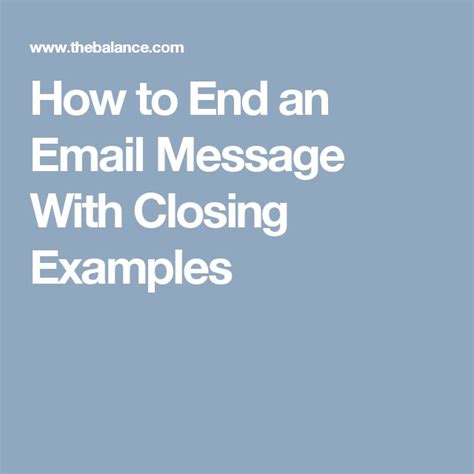Email Closing Examples & Techniques: How To Leave A Lasting Impression

Writing an email may seem like a simple task, but the way you close your message can have a significant impact on the recipient’s perception of you and your message. A poorly written email closing can leave a negative impression, while a well-crafted one can leave a lasting positive impression. In this article, we will discuss some of the best email closing examples and techniques that you can use to leave a lasting impression on your recipients.
1. Use a Clear and Concise Closing
When closing an email, it is essential to use a clear and concise phrase that gets your point across quickly. Avoid using long and complicated phrases that can confuse the recipient. Some examples of clear and concise email closings include:
- Best regards
- Kind regards
- Sincerely
- Thanks
- Yours truly
2. Match the Tone of the Email
The tone of your email should match the tone of your email closing. If you have written a formal email, then a formal closing would be appropriate. On the other hand, if you have written a casual email, then a casual closing would be more suitable. Some examples of formal email closings include:
- Respectfully
- Yours faithfully
- Best regards
Some examples of casual email closings include:
- Take care
- Warmly
- Best
3. Personalize Your Closing
Personalizing your email closing can make your message feel more human and less robotic. Use the recipient’s name in your closing to make it feel more personal. Some examples of personalized email closings include:
- Take care, John
- Have a great day, Sarah
- Best wishes, Alex
4. Include a Call-to-Action
When closing your email, include a call-to-action that encourages the recipient to take action. This could be anything from asking them to reply to your email to inviting them to a meeting. Some examples of email closings with a call-to-action include:
- Looking forward to hearing back from you
- Please let me know if you have any questions
- Let’s schedule a meeting to discuss this further
5. Express Gratitude
Expressing gratitude in your email closing can leave a positive impression on the recipient. Thanking them for their time or help can go a long way in building a strong relationship. Some examples of email closings that express gratitude include:
- Thank you for your help
- Thanks for your time
- Appreciate your assistance
6. Sign Off with Your Name and Title
When closing your email, always include your name and title. This helps the recipient know who they are communicating with and can also lend credibility to your message. Some examples of email closings with a name and title include:
7. Use a Professional Email Signature
Using a professional email signature can make your email appear more polished and leave a lasting impression on the recipient. Your email signature should include your name, title, company, and contact information. Some examples of professional email signatures include:
8. Proofread Your Email Closing
Before sending your email, make sure to proofread your email closing. Check for any spelling or grammar errors that could detract from your message’s credibility. A well-written email closing can leave a positive impression, but a poorly written one can leave a negative one.
9. Follow Up
If you don’t receive a response to your email, it is okay to follow up with a polite reminder. This shows that you are committed to the conversation and can help move the conversation forward. Some examples of email closings for follow-ups include:
- Just wanted to follow up on my previous email
- Checking in to see if you had any questions
- Would love to hear your thoughts on this
10. Conclusion
Writing a strong email closing can leave a lasting impression on your recipient. By using clear and concise language, matching the tone of your email, personalizing your closing, including a call-to-action, expressing gratitude, signing off with your name and title, using a professional email signature, proofreading your email closing, and following up, you can ensure that your message is received positively.
FAQs
Q: What is the best email closing for a professional email?
A: Some of the best email closings for a professional email include “Best regards,” “Kind regards,” “Sincerely,” “Thanks,” and “Yours truly.”
Q: Should I use a different email closing for a casual email?
A: Yes, it is appropriate to use a different email closing for a casual email. Some examples of casual email closings include “Take care,” “Warmly,” and “Best.”
Q: What should I include in my email signature?
A: Your email signature should include your name, title, company, and contact information.
Q: Why is it important to proofread my email closing?
A: Proofreading your email closing helps to ensure that there are no spelling or grammar errors that could detract from your message’s credibility.
Q: Is it okay to follow up on an email if I don’t receive a response?
A: Yes, it is okay to follow up on an email if you don’t receive a response. A polite reminder can help move the conversation forward.
